“I want I used to be the form of individual that likes to train… I’m simply not that man.”
My good friend Dave takes a sip from his completely poured pint, whereas explaining his reluctance to train.
“I’m the man who’s actually into beer,” he provides. “I’ve no real interest in train. Beer is my factor. That’s who I’m.”
Dave, like a number of individuals, is aware of train is one thing he “ought to” do. Nevertheless it holds no attraction.
Going for a run—and truly having fun with it? Unfathomable to him. The gymnasium? Overlook it.
Coaches, medical doctors, and health fanatics like to espouse the advantages of bodily exercise: It makes you are feeling good! It’s rewarding! It’s obligatory!
But, like a triple hopped IPA, train might be an acquired style. Some individuals find it irresistible at first sip, some study to find it irresistible, and others simply plain don’t prefer it.
And that’s okay.
Disliking train isn’t some form of ethical failure.
It doesn’t imply you’re damaged or lazy—it’s only a private choice.
Nonetheless, there’s no denying that train is nice for the human physique.
However how do you train once you don’t prefer it?
And when you’re a coach, how are you going to assist shoppers with this problem—with out coming off just like the health police?
We turned to our in-house PN Coaches, who collectively have many years of expertise serving to individuals transfer extra (together with loads of people who’d given up on train altogether).
On this article, they share 5 refreshing methods—plus over a dozen how-to suggestions—that may show you how to (or your shoppers) cease preventing with train.
“Why don’t others recognize train like I do?”
First, a couple of phrases to all the oldsters who’re keen about health.
Once you love one thing, it’s onerous to grasp why others don’t.
However there are many the reason why an individual may discover train disagreeable or undesirable. As an illustration…
- Previous experiences: In case your health recollections embrace being picked final for softball, hit within the face throughout dodgeball, or body-shamed within the gymnasium, you may want to take a seat within the bleachers (or keep away from sports activities altogether).
- Ache: For some individuals, sure types of motion damage. They will exacerbate continual ache, accidents, and present well being situations.
- Discomfort: Some dislike the sensation of motion, respiratory onerous, or getting sweaty. Individuals in bigger our bodies or with disabilities might discover train gear or group lessons merely aren’t constructed for them. On prime of bodily discomfort, this could set off emotions of disgrace and being “misplaced.”
- Notion: When train is handled like a chore, punishment, or a take a look at of bodily limits (“until you puke, faint, or die, hold going”) some people might opt-out altogether.
- Identification: Some individuals (like my beer ingesting good friend Dave) are turned off by health tradition. They don’t wish to be a “gymnasium bro” or be a part of a “spin cult”—their identification lies elsewhere.
Doesn’t train make individuals joyful?
Bodily exercise can present an endorphin rush, or “runner’s excessive.” (It’s additionally been proven to contribute to psychological wellness.)
However that pleasurable dose of hormones isn’t as dependable because it’s made out to be.
“Particular person response to train varies,” says Helen Kollias, PhD, science advisor at Precision Diet.
“Endorphin response might be difficult to measure, so there’s rather a lot we don’t know. Nevertheless it’s potential that some individuals might produce extra endorphins and/or be extra delicate to them. Genetic variations might play a job.”1
Dr. Kollias provides:
“The ‘runner’s excessive’ expertise even varies each day. Someday a runner might expertise an endorphin rush however nothing the subsequent.”
Backside line: Don’t assume your shoppers will expertise a scrumptious endorphin rush just by working tougher. (Nevertheless it’s a bonus in the event that they do.)
Technique #1: Cease attempting to train.
Sure, you learn that accurately.
“Cease attempting” might sound like unusual recommendation, however hear us out.
If train appears like an unimaginable, torturous job, one of the best strategy is likely to be to take it off the desk utterly.
A couple of causes:
For one, the extra you push in opposition to your individual resistance (or your shoppers’), the extra that resistance is prone to develop. Conversely, when you cease telling your self you “ought to” train, you may uncover you’re extra prone to do it.
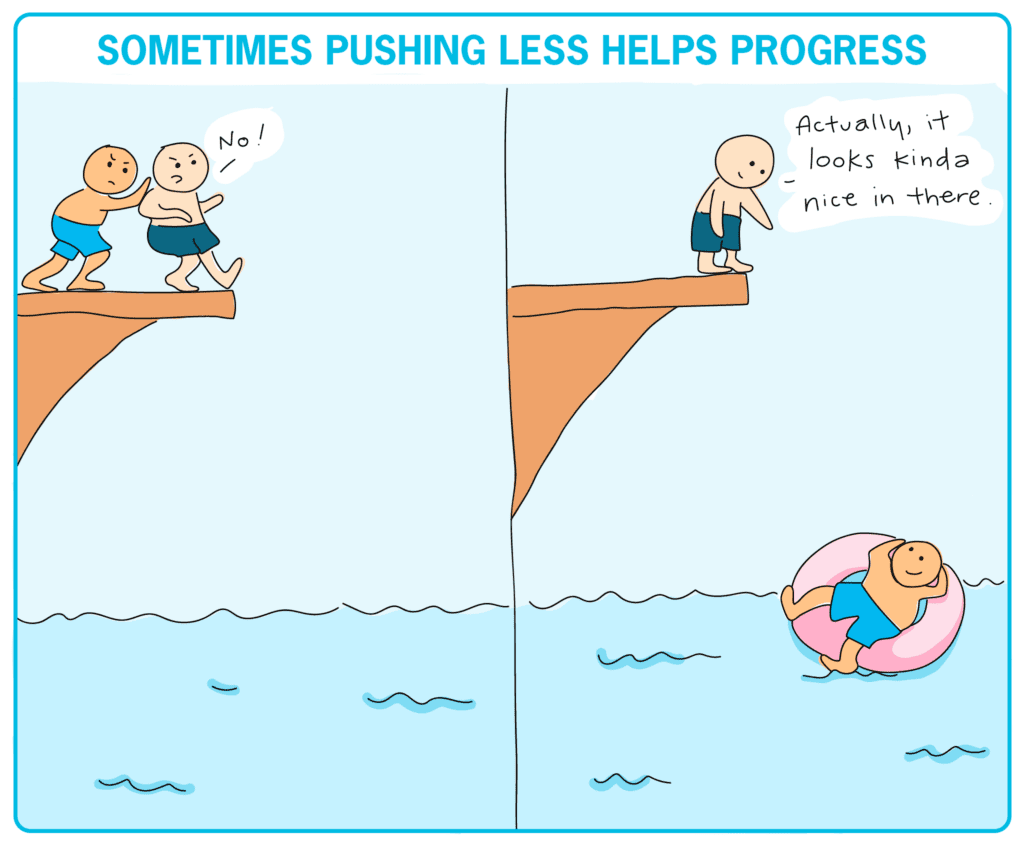
Additionally: You don’t HAVE to train.
Sure, it’s good for you. However you’re within the driver’s seat on this life. And also you get to decide on the way you spend your time and vitality.
That mentioned, if you wish to discover motion in a pressure-free approach, take a look at the following pointers.
▶ Attempt a “do nothing” experiment.
Right here’s a bizarre thought: Restrict your motion for a couple of days and see what occurs.
“When a shopper tells me they don’t wish to train, I say, ‘Nice, don’t do it. In reality, don’t even transfer. Simply lie in mattress and do as little as potential,’” says PN Grasp Coach Kate Solovieva.
And what occurs?
“Finally most individuals are going to wish to transfer ultimately, of their very own volition. They’ll say, ‘Wait a second, I really wish to transfer round a bit. I wish to go for a stroll’.”
This isn’t about tricking your self into wanting to maneuver; it’s about studying if and when motion does really feel good for you. You may uncover your physique craves motion greater than you realized.
▶ Give attention to different methods to enhance your well being.
It may be straightforward to fixate on the factor (you suppose) you’re dangerous at.
However once you do this, you possibly can miss different (doubtlessly simpler, much less anxious) alternatives for enchancment.
“Should you completely can’t or is not going to transfer in any approach, consider it like this: You continue to have loads of different methods to enhance your well being,” says PN Coach and Holistic Nutritionist Sarah Maughan.
“You would put your time and vitality into enhancing your sleep, your stress administration, your diet, and so forth. Train isn’t the one ingredient in a wholesome life.”
Of all of the health-improving choices out there to you, what’s most interesting? Make that your precedence for now.
▶ Construct your bucket checklist.
Relatively than obsessing over how a lot you hate the gymnasium, Solovieva suggests placing the deal with what you need to do.
“Typically, I’ll say: ‘Okay, let’s put train apart for some time. As an alternative, let’s discuss bucket checklist. Inform me in regards to the belongings you’re interested in, the belongings you wish to attempt earlier than you die’.”
The objects in your bucket checklist may naturally encourage you to get transferring (maybe you wish to be match sufficient to cycle round Amsterdam or climb a volcano in Hawaii). Or not.
Regardless, the “bucket checklist” train can shift your focus in the direction of what you need for your self—which might be significant and energizing, it doesn’t matter what you select.
Brainstorm a bunch of belongings you wish to attempt in your lifetime. Then think about: Which of those might you begin working in the direction of at this time?
Technique #2: Goal for “motion” reasonably than “train.”
“Individuals usually assume they should go straight into coaching for a marathon or lifting heavy weights,” says Solovieva. “However with a purpose to get the good thing about motion, you don’t have to coach. You may simply transfer.”
And when you’re questioning the way you’ll discover huge blocks of time to train—and even transfer?
“You don’t essentially have to schedule time to train,” says Maughan. “Your motion might simply be a pile of mini actions that add up over the day.”
These “mini actions” might be something: strolling to the workplace water cooler for a drink; emptying the dishwasher or mowing the garden; goofing round along with your children.
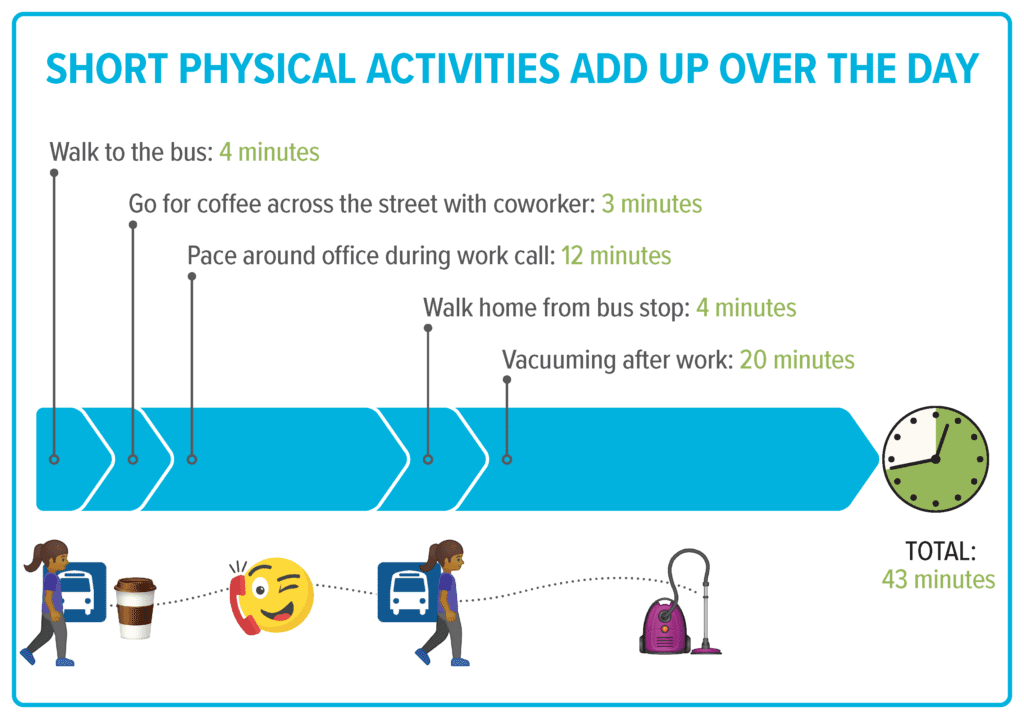
Bonus: Analysis reveals that once you deal with train as enjoyable or play (reasonably than work), you’ll be much less liable to hedonic compensation—the phenomenon of loading up on treats post-workout, negating a calorie burn, if that’s what you’re after.2
Both approach: Transferring reasonably than exercising may really feel extra accessible—and have much less baggage hooked up to it.
Need to get transferring? Attempt the following pointers.
▶ Goal to barely enhance the methods you already transfer.
PN Coach Jeremy Fernandes factors out that even when you hate motion, you is likely to be doing greater than you suppose.
“Except you’re actually mendacity in mattress all day, you’re in all probability getting some form of motion. Simply getting up within the morning, making breakfast, attending to work—all these items require motion, says Fernandes.
“So the actual query is, How will you increase on the motion you’re already doing?”
For instance—might you tempo the toilet when you brush your tooth? Circle the block after you are taking out the trash? Stroll the canine for an additional jiffy? And so forth.
▶ Lean into the “principally inactive” belongings you take pleasure in.
“One shopper of mine wished to maneuver extra, however motion wasn’t her factor,” says Solovieva. “Her ardour was cooking. So we centered on that: I inspired her to prepare dinner extra, to take a look at new recipes, and so forth.”
Right here’s the attention-grabbing half:
“The extra she obtained into cooking, the extra she moved. With out attempting, she naturally turned extra bodily lively by grocery procuring, chopping, selecting up pots and pans, and transferring round her kitchen.”
In time, Solovieva’s shopper grew extra comfy transferring. (She even finally graduated to some dwelling exercises.)
Cooking isn’t your solely possibility. Many hobbies contain motion, even when they aren’t seen as “health actions.” For instance:
- Like to learn? Stroll to the library or stroll round a bookstore.
- Like to color? Attempt portray on a bigger canvas so that you’re inspired to face and make some bigger arm actions.
- Procuring fanatic? As an alternative of procuring on-line, saunter by way of the mall or native retailers.
And hey, when you’re a beer fan like my buddy Dave, possibly do a brewery tour, or stroll to the beer retailer as a substitute of driving.
▶ Embrace the “every thing counts” philosophy.
Get this: Simply pondering that your every day actions “rely” in the direction of your health targets could make a distinction.
One examine performed out of Harvard College discovered that if we consider our every day actions (like housekeeping or baby care) rely as train, the physiological good thing about these actions is enhanced.3
The placebo impact could be a authentic solution to enhance bodily health, with out altering your every day routine.
So, take into consideration your every day routines, and recognize how the actions you do are already contributing to your well being.
Technique #3: Do Much less.
To reap the advantages of motion, you may want lower than you suppose.
In line with the CDC Bodily Exercise Pointers, adults ought to purpose to get 150 to 300 minutes of moderate-intensity bodily exercise every week (or 22 to 43 minutes a day).4
(Be aware: Time-crunched people also can meet the rules by doing 75 minutes of vigorous-intensity train per week.)
However train isn’t all-or-nothing: The whole lot counts.
If the above suggestions sound overwhelming to you, attempt the following pointers.
▶ Break your aim into manageable items.
In her ebook, The Play E book: Get Within the Behavior of Good Well being, coach and play knowledgeable Janet Omstead, PN2-MHC, suggests:
“If 22 minutes all of sudden appears like an excessive amount of, simply break up that 22 minutes into smaller chunks.”
For instance, 22 minutes damaged up over the course of the day might seem like:
- 5 minutes of motion 5 occasions
- 8 minutes of motion 3 occasions
- 11 minutes of motion 2 occasions
(Small however efficient train “snacks” are additionally known as “set off exercises.” Learn extra about them right here: The intermittent exercise methodology that would rework the best way you train)
▶ Begin small and construct slowly.
“It’s also possible to make 22 minutes the aim reasonably than the place to begin,” says Omstead.
“You may even take a yr, or longer to work as much as 22 minutes. For instance, when you begin at 5 minutes per day and add 1 minute per day every month, on the finish of a yr you’d be at 17 minutes a day—and also you’ll have constructed an everyday every day behavior, one thing many individuals by no means obtain.”
▶ Discover the continuum.
If train looks like an all-or-nothing form of factor (you’re both coaching for an IronMan or in full-on sofa potato mode), begin pondering on a spectrum.
“I ask shoppers to think about a continuum from 0 to 10,” says Solovieva. “If 10 is ‘I transfer on a regular basis and do every thing completely’ and 0 is ‘I don’t transfer in any respect and simply lie on the sofa until I kick the bucket’, what are some choices in between?”
A technique to consider that is to think about motion as a dial or quantity knob. Should you had been to show your quantity knob up a bit—say a 2/10 or a 3/10—what may that seem like?
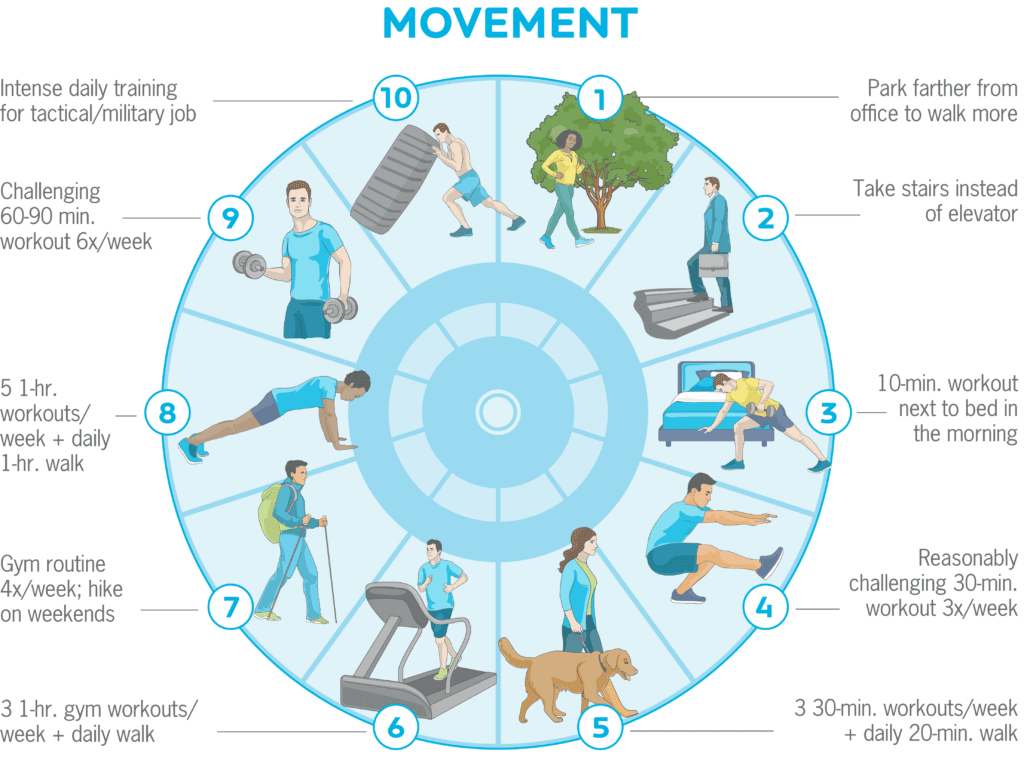
Once you discover the continuum you may discover a stage of exercise that feels doable for you.
(And hey—this “dial” methodology works for principally all your well being habits. Study extra: By no means press “pause” in your well being and health once more. This free device is your secret weapon)
Technique #4: Attempt stuff.
Should you do wish to transfer extra—and ideally, discover one thing you want, if not love—there’s no getting round it:
You’ll have to present some issues a attempt.
That possibly means doing a little stuff you may not like. Fortuitously, there are methods to make the experimentation course of extra enjoyable (or at the least, not terrible).
Listed here are some concepts.
▶ Apply the ten minute rule.
“Give your self permission to attempt simply 10 minutes of one thing. Should you don’t prefer it, you possibly can cease,” says PN Coach Pam Ruhland.
This low-pressure strategy makes it simpler to attempt new issues: Get within the pool along with your children for simply 10 minutes and see the way it goes. Attempt 10 minutes of a web-based Zumba class or a yoga video on YouTube.
“Figuring out you possibly can give up could make it simpler to get began—which is definitely the toughest half,” says Ruhland.
▶ Return to belongings you used to love.
“How did you like to play once you had been younger? Begin there,” says Omstead.
“Make a listing of all of the methods you really liked to play and be lively once you had been a child. Did you soar rope? Play soccer? Discover the forest? Chase the ice cream truck down the road?”
Choose one thing out of your checklist and check out it. Sure, it is likely to be tougher as an grownup. (The place do children get the vitality to leap rope for hours?) Nevertheless it may additionally rekindle your playfulness.
And don’t neglect, you possibly can at all times give up after 10 minutes.
▶ Create your “bingo card” of recent actions.
Even when you suppose you hate ALL train, there are in all probability belongings you haven’t tried.
To experiment, Solovieva suggests making a “bingo card” of recent actions.
She explains: “On every sq., put an exercise you’d wish to attempt: possibly yoga goes on one sq., zumba, mountain climbing, boxing, and so forth.”
Then, for the subsequent 30 or 60 days, purpose to fill the bingo card by attempting every exercise.
“In the long run, possibly you’ll nonetheless hate every thing you tried,” says Solovieva. “However even when you don’t just like the actions themselves, the method of experimenting might be weirdly enjoyable.”
(Should you like this concept, obtain our free PDF: Motion Bingo)
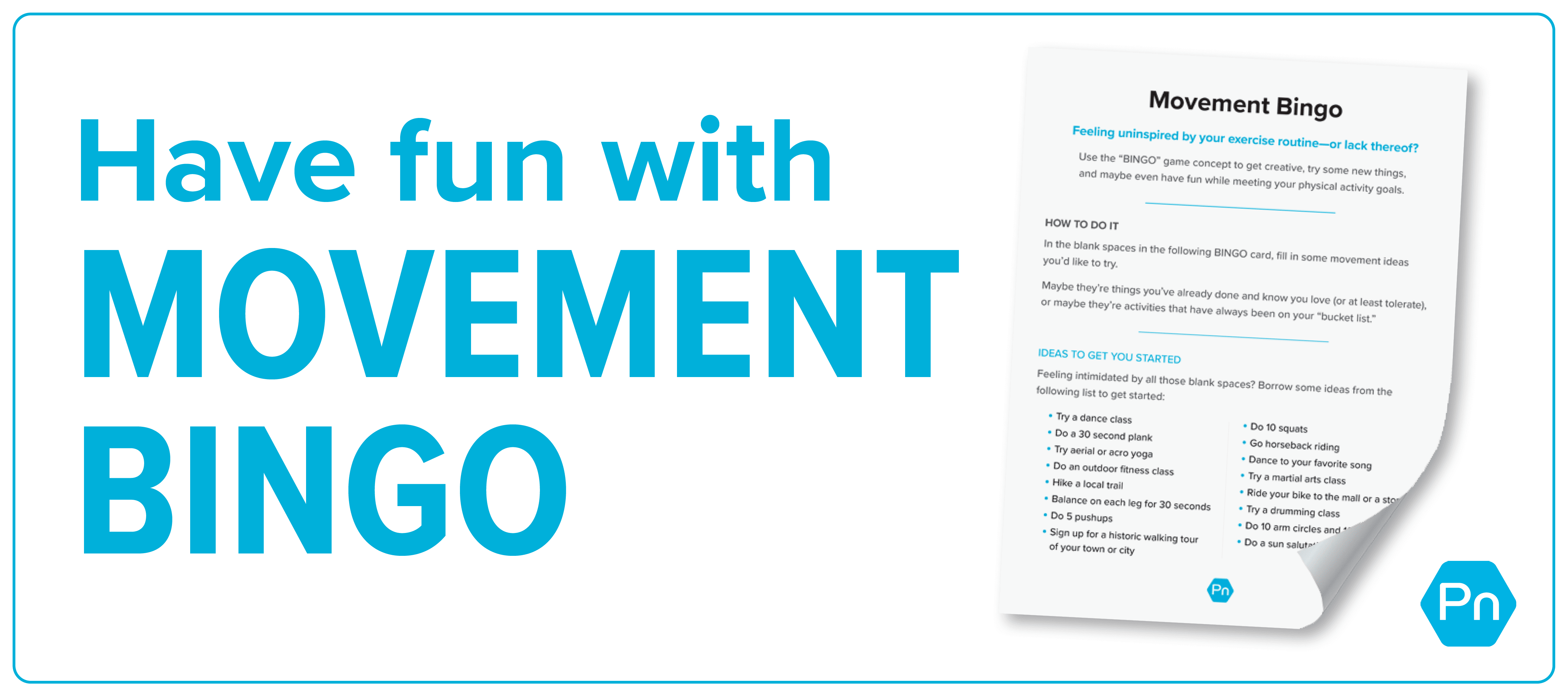
Technique #5: Modify your expectations.
Health tradition has exploded. This could be a good factor when it encourages individuals to get lively and check out new issues, nevertheless it may also be, effectively, intense.
Today, it appears you possibly can’t simply throw on some sweats and transfer your physique; it’s important to go full BEAST MODE.
And it’s not sufficient to simply get it completed, it’s important to do one thing you LOVE [unicorn emoji, rainbow emoji, heart emoji].
Plus, your efforts ought to in some way lead to six-pack abs regardless of your age, gender, and way of life. #noexcuses
FACEPALM.
Let’s take the expectations down a notch, lets?
Fact is, motion doesn’t require something fancy, or should yield some magical transformation in a single day.
By adjusting your expectations round train, you may make the entire thing much less of an ordeal… possibly much more enjoyable.
Right here’s what that may seem like.
▶ Don’t fear about “loving it”—purpose for “meh” as a substitute.
Train advocates will let you know to “discover one thing you’re keen on.” However for a few of us, “love” is just too robust of a phrase.
Working example: Someday, Fernandes requested a beforehand inactive shopper what she beloved about her new exercise routine.
Her reply shocked him.
“I don’t love any of this,” she mentioned. “I don’t love strolling. I don’t love going to the gymnasium. What I do really feel is a way of contentment after I’ve completed it.”
However you understand what? That’s okay, says Fernandes.
“The nice new is that you just don’t should find it irresistible. The aim is to seek out one thing tolerable that provides some worth to your life.”
Consider it like brushing your tooth: “Nobody will get actually enthusiastic about doing it, however you understand it’s essential to your well being, and it feels good after you do it,” says Fernandes.
▶ Be nicer to your self.
Years in the past, a good friend and I agreed we’d begin figuring out.
With out intending to take action, we each took completely different approaches:
The evening earlier than, I’d write little notes of encouragement for myself to see very first thing within the morning. Stuff like, “You’re a badass.”
My good friend, nevertheless, would get up and say to herself: “Rise up you lazy bum. That weight isn’t going to lose itself.”
Guess which one among us made it to our exercise? (It was me.)
These outcomes aren’t simply anecdotal:
We interviewed a bunch of PN Licensed coaches about what causes shoppers to give up, they usually all agreed that “beating themselves up” was the #1 issue.
Analysis additionally reveals that self-compassion—being variety and supportive to your self—is positively related to health-promoting behaviors like maintaining a healthy diet, exercising, prioritizing sleep, and managing stress.5 6
(Need to give self-compassion go? Take a look at our Self-Compassion Quickie.)
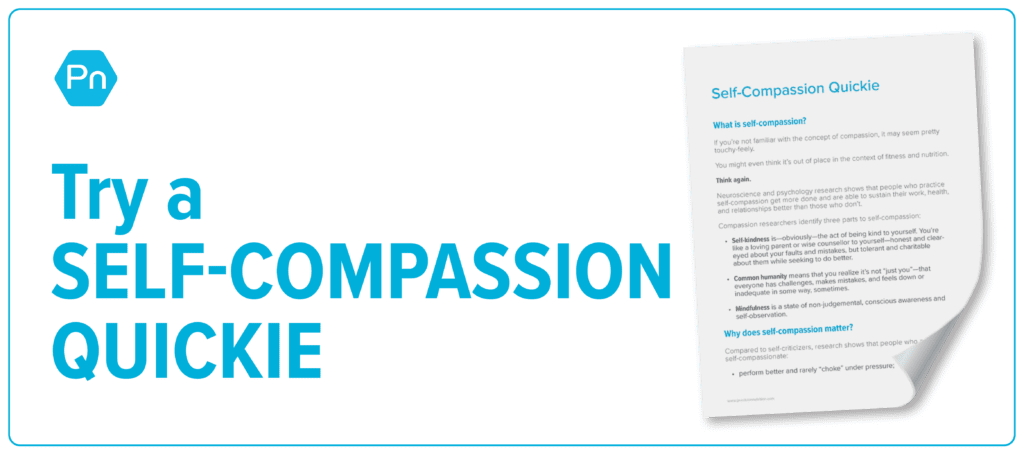
It is sensible: Being a jerk to your self just about ensures you’re not going to have a very good time, it doesn’t matter what you’re doing.
So, watch your self-talk. Attempt to be variety and inspiring, and provides your self a gold star to your efforts, regardless of how small.
Possibly even write a pleasant word for your self. Sounds tacky, nevertheless it works.
References
Click on right here to view the data sources referenced on this article.
Should you’re a coach, otherwise you wish to be…
You may assist individuals construct diet and way of life habits that enhance their bodily and psychological well being, bolster their immunity, assist them higher handle stress, and get sustainable outcomes. We’ll present you ways.
Should you’d wish to study extra, think about the PN Stage 1 Diet Teaching Certification.




